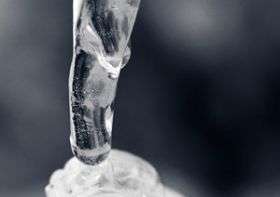Atoms Fly Apart in Direct Crystal Melting

Using an intense laser and ultra-fast x-rays, Stanford Synchrotron Radiation Laboratory (SSRL) researchers have observed the atomic events involved in rapid crystal melting.
Ordinary thermal melting determines the fate of an ice cube in a cup of tea or an icicle out in the blazing sun. The slow-acting heat causes atomic nuclei within the ice to vibrate destructively, disrupting the chemical interactions between the atoms. This allows the ice to relax its shape from an ordered crystal to a disordered liquid.
At the Sub-Picosecond Pulse Source (SPPS), scientists used an alternative route to crystal melting that enabled them to make a "movie" of the atomic motions that lead to crystal disordering. The international collaboration used an ultra-fast, high-energy laser to rapidly heat the electrons in a crystal without heating the atomic nuclei; the laser warmed the outer electrons while leaving the heavy core of the atom cold. In this "electronically driven melting," the electrons gained energy and flew out of their regular orbit around the core, instantly breaking the chemical bonds they had shared with electrons from neighboring atoms.
Short bursts of x-rays provided by the SPPS measured the atomic positions of the atoms in a semiconductor material. The data, published recently in Physical Review Letters, revealed that when their bonds destabilized, the atoms moved apart from each other quickly, as if repelling each other. The semiconductor material had visible melting damage after being struck by the laser.
"This research provides verification that intense ultra-fast x-ray sources like the upcoming Linac Coherent Light Source (LCLS) will make possible the study of previously inaccessible material properties," said SSRL researcher Patrick Hillyard.
Source: by Heather Rock Woods, Stanford Linear Accelerator Center





















